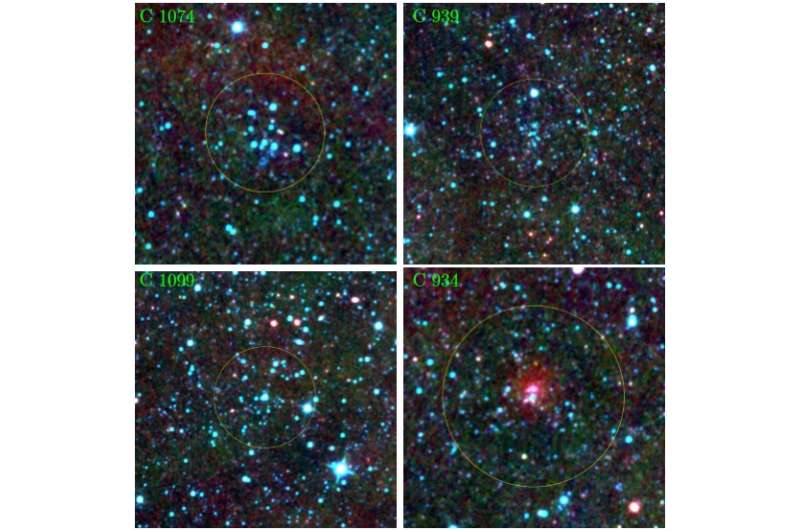July 25, 2016 report
Seven new embedded clusters detected in the Galactic halo

(Phys.org)—A team of Brazilian astronomers, led by Denilso Camargo of the Federal University of Rio Grande do Sul in Porto Alegre, has discovered seven new embedded clusters located unusually far away from the Milky Way's disc. The findings, presented in a paper published July 3 on arXiv.org, could provide new insights on star cluster formation.
Embedded clusters are stellar clusters encased in an interstellar dust or gas, consisting of extremely young stars. They are crucial for astronomers to better understand star formation and early stellar evolution. Studying these clusters could reveal the origin of stellar masses as well as the origin and evolution of protoplanetary disks, where planet formation processes take place.
In the Milky Way galaxy, most of embedded clusters lie within the thin disc less than 1,000 light years from the galactic midplane, especially in the spiral arms. However, Camargo and his team detected two young stellar clusters earlier this year, and now, after spotting seven more, suggest that they could be more common on the outskirts of the galaxy than previously thought.
"Now, we discovered seven star clusters far away from the Milky Way disc. Thus, this work points to a new paradigm in the star and star cluster formation, in the sense that the formation of such objects occurs in the halo and it seems to be frequent," Camargo told Phys.org.
The scientists found the new clusters by analyzing the data provided by NASA's Wide-field Infrared Survey Explorer (WISE). This space telescope is monitoring the entire galaxy in infrared light, snapping pictures of mainly remote galaxies, stars and asteroids. WISE was chosen for this job as it captures embedded clusters that are invisible at optical wavelengths, due to the fact that they are engulfed in significant amounts of interstellar dust.
"WISE provided infrared images of the entire sky, allowing us to penetrate the gas and dust within giant molecular clouds, in which the star formation can take place. Recently, we discovered more than 1,000 embedded clusters using WISE," Camargo said.
According to the research paper, three newly found objects, designated C 932, C 934, and C 939, are high-latitude embedded clusters, projected within the newly identified cloud complex. These clusters are located at a vertical distance of about 16,300 light years below the galactic disc. Other new clusters, named C 1074, C 1099, C 1100, and C 1101, are in the range from 5,500 to 10,400 light years above the disc. All these clusters are younger than five million years.
The team noted that the new findings indicate that a sterile galactic halo could host ongoing star formation. The newly detected embedded clusters provide evidence of widespread star cluster forming processes far away from the Milky Way's disc.
"The discovery of stellar clusters far away from the disc suggests that the Galactic halo is more actively forming stars than previously thought. Moreover, since most young clusters do not survive for more than five million years, the halo may be raining stars into the disc. The halo harbors generations of stars formed in clusters like those hereby detected," Camargo said.
Before the team's paper was published, it was thought that star formation processes in the Milky Way occur in the disk, but not in the halo. Thus, as Camargo concluded, this new study represents a paradigm shift, in the sense that a sterile halo becomes now a host of ongoing star formation.
More information: New detections of embedded clusters in the Galactic halo, arXiv:1607.00672 [astro-ph.GA] arxiv.org/abs/1607.00672v1
Abstract
Until recently it was thought that high Galactic latitude clouds were a non-star-forming ensemble. However, in a previous study we reported the discovery of two embedded clusters (ECs) far away from the Galactic plane (∼5 kpc). In our recent star cluster catalogue we provided additional high and intermediate latitude cluster candidates. This work aims to clarify if our previous detection of star clusters far away from the disc represents just an episodic event or if the star cluster formation is currently a systematic phenomenon in the Galactic halo. We analyse the nature of four clusters found in our recent catalogue and report the discovery of three new ECs with unusually high latitude and distance from the Galactic disc midplane. All of these clusters are younger than 5 Myr. The high-latitude ECs C 932, C 934, and C 939 appear to be related to a cloud complex about 5 kpc below the Galactic disc, under the Local arm. The other clusters are above the disc, C 1074 and C 1100 with a vertical distance of ∼3 kpc, C 1099 with ∼2 kpc, and C 1101 with ∼1.8 kpc. According to the derived parameters there occur ECs located below and above the disc, which is an evidence of widespread star cluster formation throughout the Galactic halo. Thus, this study represents a paradigm shift, in the sense that a sterile halo becomes now a host of ongoing star formation. The origin and fate of these ECs remain open. There are two possibilities for their origin, Galactic fountain or infall. The discovery of ECs far from the disc suggests that the Galactic halo is more actively forming stars than previously thought and since most ECs do not survive the textit{infant mortality} it may be raining stars from the halo into the disc, and/or the halo harbours generations of stars formed in clusters like those hereby detected.
© 2016 Phys.org





















